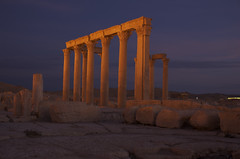It was oddly fitting that the New Yorker I bought on my most recent transatlantic journey carried a story on the Californian drought. I was on my way to San Francisco and looking for some context. Work trips of a few days only don't usually offer much in that regard, but the New Yorker delivered.
California has been in a drought the last four years. Growing cities battle with profligate agriculture for decreasing resources. There's little snow in the Sierras and it doesn't rain. Water tables sink, wetlands run dry, rivers silt up. Coastal cities and farming communities alike fear for the future, but vested interests and hard lobbying on both sides make finding a solution difficult.
Introducing hot air into a situation where cold rain is needed, SFO has put huge posters into their restrooms alerting passengers that "California is in a drought. SFO's faucets save 30% more water". No point of reference is given. Thirty per cent more than what? Might the faucets just save 30% water, and marketing thought the message would be more convincing with excess verbosity?
In any case, the entire airport managed to save 14% of water over the past seven years, as another huge poster claimed without any embarrassment or contrition. The marketing department was probably relieved to have found anything positive at all, but 14% isn't a whole lot if a near-total lack of rain is the situation. Fourteen percent over seven years is less than a percent and a half each year.
Where is water wasted? In California, that's a question that's easy to answer but whose answers are hard. Average water consumption in the state has decreased by 50% recently, which shows that the problem is being taken seriously and that great efforts are being made. On the other hand, average water consumption is still twice as high as in central Europe.
The easiest place for cuts is also the hardest. The most lavish waster of water is agriculture. Despite employing only 3% of Californian workers and contributing a mere 2% of the state's economic output, agriculture uses 80% of its water. For historic reasons, water is not a commodity but a right, unmetered. Driving along Highway 1 north from Halfmoon Bay, I saw fields being irrigated in the heat of the afternoon. I'd be surprised if more than half of the sprayed water escaped evaporation and hit the ground to nourish the plants. But where no one is counting and no one is charged, waste is a rampant. Similarly, the San Joaquin valley is still happily growing grass for export to China. Grass! In a drought!
Grass has largely disappeared from the campus of Stanford University where I went for a run one morning before giving a talk at a workshop. It still gave the impression of being green, but underneath the shrubbery, there was nothing but dust. It hadn't rained in a while, and the sprinklers weren't asked to compensate. A friend I visited in San Francisco claimed with the black humor of the powerless that the drought had been good for the weather. Since she had moved there two years earlier, it's been sunny most of the time and even the fog wasn't as bad as everyone had warned.
This last comment reminded me of London and the rain, whose connection has become much looser in the last decade or two. Some blame this on global climate change. Maybe that's at fault in California as well. One alternative explanation, a few years of extreme weather, is much easier to contemplate, but it could also be another, a reversion to the mean, the end of a century or so of exceptionally wet weather, as some studies suggest. T.C. Boyle's novel A Friend of the Earth, which I didn't much like five years ago, might yet turn out to be prescient.

No comments:
Post a Comment